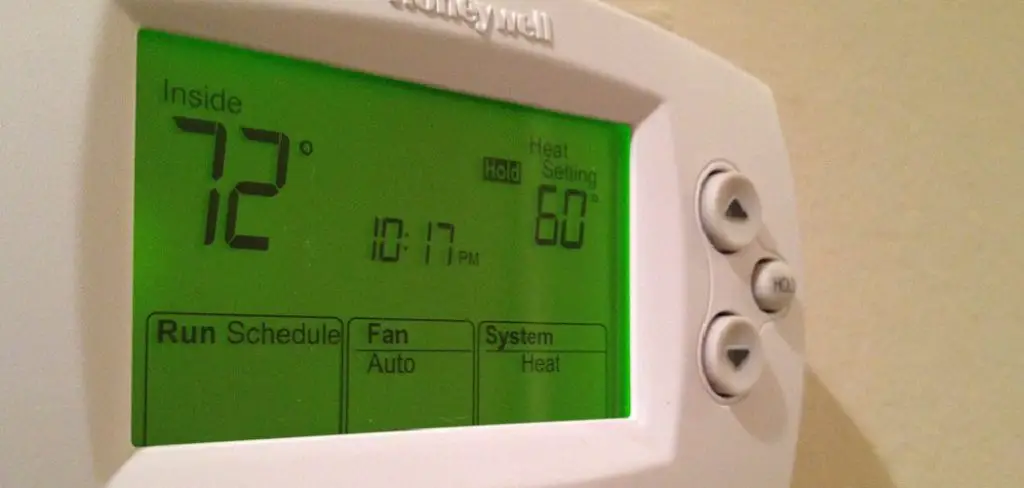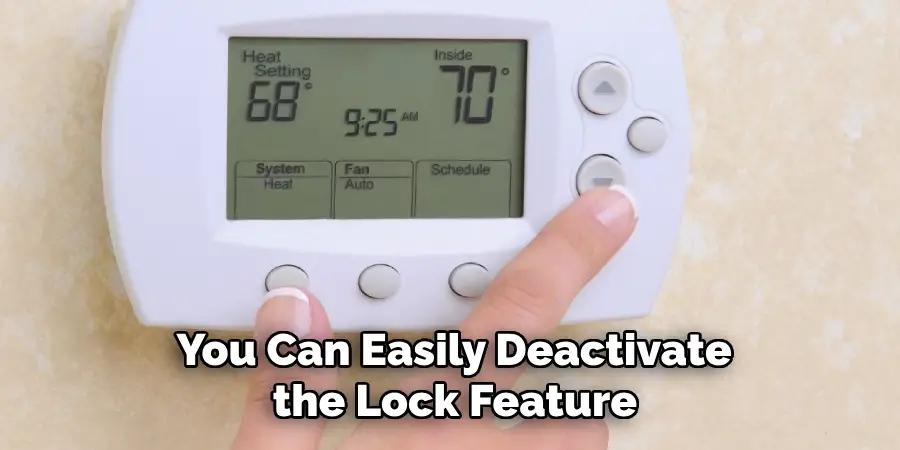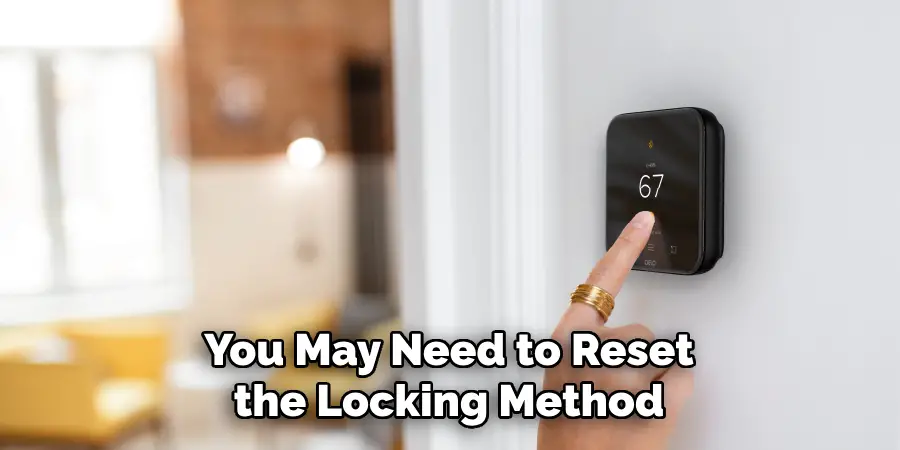Are you tired of wasting energy and money because your thermostat is always changing temperature settings due to unauthorized tampering? If so, we’ve got the solution for you – learn how to lock your thermostat! Locking your thermostat helps ensure that only those approved by you can alter its settings.

This ensures that no one else will adjust it to an unnecessary or too-high level while also saving energy in the long run. In this blog post, we’ll walk you through step-by-step how to lock thermostat so you can stay comfortable and save money all at once. So let’s get started!
Step-by-step Guidelines on How to Lock Thermostat
Step 1: Know Your Thermostat
Before you can lock your thermostat, it’s important to understand how it works. Most thermostats have a locking feature built-in, but the location and method of activation may differ depending on the brand and model. Familiarize yourself with your specific thermostat by reading the user manual or contacting the manufacturer.
Step 2: Find the Lock Button or Feature
Once you know your thermostat, look for a lock button or feature. This is typically located on the device itself, but in some cases, it may be accessed through a menu screen. If you can’t find the lock feature on your own, refer to the user manual for assistance. Mostly, a lock icon or word will be shown on the screen.
Step 3: Activate the Lock Feature
Now that you’ve located the lock button or feature, it’s time to activate it. This can be done by pressing and holding down the lock button or selecting the lock option on the menu screen. Some thermostats may require a PIN code to be entered to activate the lock.
Follow the prompts on your specific thermostat to complete this step. Once activated, the lock feature will prevent any changes to the temperature or settings until it is deactivated.
Step 4: Deactivating the Lock Feature
In case you need to adjust your thermostat’s settings, you can easily deactivate the lock feature. This can be done by following the same steps as activation – pressing and holding down the lock button or selecting the unlock option on the menu screen. Again, some thermostats may require a PIN code for deactivation. Once unlocked, you can make any necessary changes and then reactivate the lock feature once you are finished.

Following these simple steps will help you successfully lock your thermostat and prevent any unauthorized changes. It’s a quick and easy process that can save you energy, money, and frustration in the long run. Now you can rest assured that your thermostat is set to your preferred temperature and won’t be tampered with by anyone else. Don’t forget to refer back to this guide if you ever need to adjust the lock feature or have any additional questions. Happy locking!
Additional Tips and Tricks for Locked Thermostat
1. If you want to physically prevent someone from changing the temperature on your thermostat, you can use a locked box or cover. This will require a key or combination to access the thermostat controls. You can find these types of lock boxes at most hardware stores.
2. Consider installing a smart thermostat that allows you to remotely control the temperature settings. This way, you can easily adjust the temperature without having to physically access the thermostat. Some models even allow you to set up passcodes or restrictions for certain users, making it easier to maintain control over your thermostat.
3. If you are using a thermostat with a password or access code, make sure to change it periodically. This will prevent anyone from memorizing the code and gaining unauthorized access to your thermostat.
4. Use an app or online portal to monitor your thermostat settings. This can be helpful in identifying any unusual temperature changes that may indicate someone has tampered with the controls.

5. Consider setting up alerts for temperature changes. This way, you will be notified if someone tries to adjust the temperature without your knowledge.
6. If you have a vacation home or rental property, consider using a tamper-proof thermostat that can only be accessed by authorized personnel.
7. In addition to locking your thermostat, make sure to secure all other entry points in your home such as doors and windows. This will help prevent unauthorized access to your thermostat.
8. Regularly check the manual or online resources for your specific thermostat model to ensure you are utilizing all available security features. Technology is constantly evolving, so it’s important to stay updated on any new features that may be added to your thermostat.
9. If you have children in the home, consider educating them on the importance of not tampering with the thermostat and explain any consequences for doing so. This will help instill a sense of responsibility and respect for your home’s heating and cooling system.
Following these additional tips and tricks can help ensure your thermostat remains locked and controlled, providing you with peace of mind and potentially saving you money on energy costs. Remember to always prioritize safety and security when it comes to protecting your home’s temperature settings. So be vigilant, informed, and proactive in taking care of your locked thermostat.
Things You Should Consider to Lock Thermostat
1. Type of Thermostat:
There are different types of thermostats available in the market. Some of the common ones include mechanical, digital, programmable, and smart thermostats. Before deciding to lock your thermostat, it is essential to consider which type you have at home as some locking methods may not be suitable for all types. Digital thermostats, for example, are easier to lock compared to mechanical ones.
2. Reasons for Locking:
Locking the thermostat is a great way to limit access and avoid unauthorized changes in temperature settings. However, it is important to determine the reasons for wanting to lock your thermostat. For instance, if you have children at home who like playing with the thermostat, locking it can help prevent them from changing the temperature and causing discomfort.
3. Available Locking Methods:
There are various ways to lock your thermostat, such as using a physical lockbox or digital password. It is crucial to research and understand which method works best for your specific type of thermostat. For smart thermostats, you may have the option to set a PIN code or use biometric identification, while mechanical thermostats may require a lockbox.
4. Compatibility with Other Systems:
If you have a home automation system in place, it is essential to check the compatibility of your chosen locking method with the system. Some locks may not work well with certain systems, which can cause inconvenience and defeat the purpose of locking your thermostat in the first place. This is especially important for smart thermostats, as they often integrate with other smart home devices.

5. Ease of Use:
It is important to choose a locking method that is easy to use but difficult for others to figure out. For example, using a complicated password or biometric identification can be effective in preventing unauthorized access. However, it should also be easy enough for you to remember without having to write it down or constantly reset it.
Following these considerations can help you determine the best way to lock your thermostat and provide peace of mind knowing that your temperature settings are secure. It is also important to regularly review and update your locking method as needed, especially if changes occur in your household or to the thermostat itself.
By taking these steps, you can ensure a comfortable and secure home environment for yourself and your family. So, consider these factors and make an informed decision when it comes to locking your thermostat.
Frequently Asked Questions
Can I Lock My Thermostat if It is Part of a Shared Heating and Cooling System?
Yes, you can still lock your thermostat even if it is connected to a shared heating and cooling system. However, it is important to communicate with the other users in the household about the locking method and ensure that they are aware of any changes made to the temperature settings.
Can I Program the Locking Method to Only Activate During Certain Times?
Yes, some smart thermostats offer the option to schedule your locking method to activate during specific times. This can be useful if you want to restrict access during certain hours or when no one is at home.
What If I Forget My Lock Code or Password?
If you forget your lock code or password, you may need to reset the locking method and set a new code. It is important to have alternative methods in place in case this happens, such as having a backup lockbox with a spare key or setting up multiple authorized users for digital locks.

Can I Still Adjust the Temperature Settings While My Thermostat is Locked?
Yes, most locking methods allow you to temporarily unlock the thermostat to make adjustments. This can be useful for unexpected temperature changes or if you need to override the lock for any reason.
Are There Any Other Benefits of Locking My Thermostat?
Aside from preventing unauthorized temperature changes, locking your thermostat can also help save energy and lower utility bills. By limiting access, you can ensure that your desired temperature settings are maintained and not unnecessarily adjusted. So, consider locking your thermostat for added security and cost savings.
Conclusion
Knowing how to lock thermostat can be beneficial for maintaining a comfortable and secure home environment. By considering the type of thermostat, reasons for locking, available methods, compatibility with other systems, and ease of use, you can choose the best locking method for your specific needs. It is also important to regularly review and update your locking method as needed to ensure its effectiveness.
With these tips in mind, you can confidently lock your thermostat and enjoy a worry-free experience. So, take the necessary steps to secure your thermostat and enjoy peace of mind for years to come. Happy locking!
